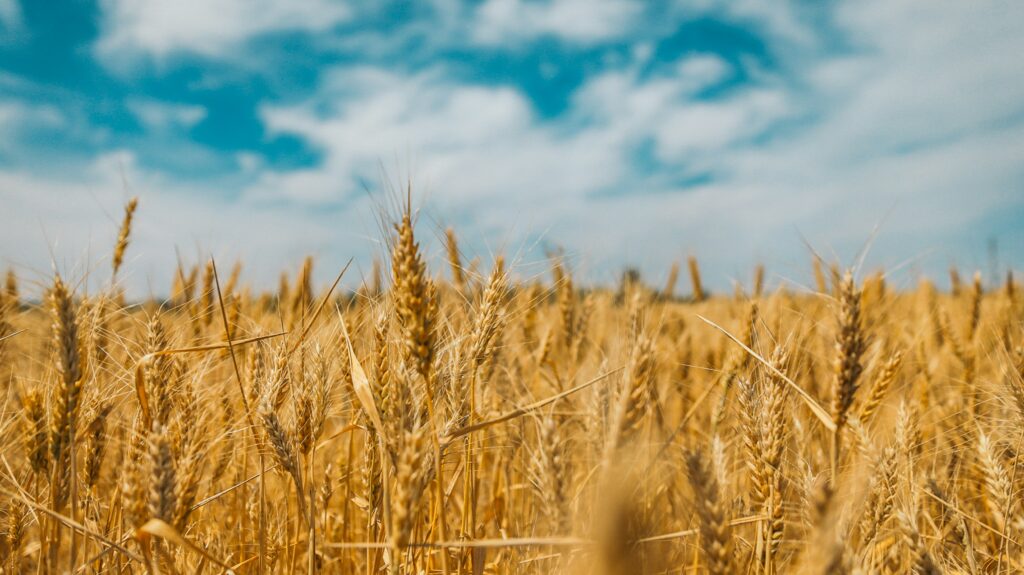Grain production is a huge part of agriculture in Michigan, making up nearly 28% of farmland in Michigan based on the 2017 Census of Agriculture. Unsurprisingly, corn was the top grain in production in Michigan, coming in at over 2 million acres harvested, followed in descending order by wheat, oats, rye, barley, sorghum, and millet. But what exactly is a grain?
For the most part, it’s the harvested seed of a grass! First domesticated 10,000-12,000 years ago, grains were one of the first crops grown by humans. They are highly adaptable and can be planted in spring or fall. Most grain production in present day is mechanized due to the intensive labor required to plant, weed, harvest, clean, and sort.

Types of Grains
While Michigan does have significant grain production with the most common grains, other grains include einkorn, emmer, Kernza®, khorasan, rice, spelt, and teff.
All of the grains above are true, grass-family grains. But with most things in life, it’s not quite that simple. There is also a category known as “pseudocereals,” which are still seeds but from plants in a different family (and are gluten-free!). Some pseudocereals include buckwheat, amaranth, quinoa, and wild rice, which have gained popularity over the last few years as gluten-free eating became more popular.
Also falling into the grain category are dry beans and oilseeds (think soybeans, sunflower seeds, peanuts, flax, etc.) While not technically a grain, they provide fat and protein which are essential to the human diet, with the added benefit of being gluten-free.
What is multigrain and how is it different from whole grain?
“Multigrain” is a word that is plastered all over bread, cracker, cereal, and chip packaging. And its definition is actually very straightforward: it’s a product that contains more than one type of grain!
But don’t get this confused with “whole grains.” Whole grains are whole seeds from a plant and include three parts: the bran, the germ, and the endosperm. Each part of the grain, also known as a kernel, is edible and contains different vitamins, minerals, proteins, fats, and carbs, which explains why eating whole grains is considered to be a healthy habit.
Including the whole grain in flour makes the taste stronger and more nuanced because the germ and the bran hold the most flavor. However, the addition of fat from the germ and the bran can cause whole grain flour to spoil faster than traditional white flour, which is sifted to remove those parts. All the more reason to start milling flour at home, and using it while fresh–read on for details!
What does stone-ground mean?
There are two ways to turn grain into flour: stone-grinding or roller milling. Stone-ground flour was made for thousands of years using two millstones to grind grain into a fine powder. Roller milling was invented during the Industrial Revolution and grinds the grains between two pieces of steel.
Stone-ground flour is often more nutritious, as it is more likely unsifted and therefore comprised of whole grains (but not always, so check product labels!)
When choosing whole-grain stone-ground flour versus roller-milled flour, keep in mind that roller-milled flours often rise more effectively, which leads to fluffier baked goods. But whole-grain stone-ground flour’s unique characteristics are worth exploring; it can be helpful to experiment with different ratios of stone-ground and roller-milled flours in recipes to find the ideal flavor and texture.

Home Flour Milling
Milling flour at home is not only a fun activity but makes for super delicious, homemade baked goods whose flavor can be tweaked to suit your family’s preferences. And with many different countertop mill options, it shouldn’t be hard to find an effective but easy-to-use mill. Even Kitchen-Aid makes an attachment for their stand mixers! Although fresh flour has a shorter shelf life, un-milled grains last indefinitely, so you can mill exactly what you need for a recipe and not worry about food waste!
To mill at home, start with whole-grain berries. Use the finest setting available on the mill, which may require a second pass-through to get to the desired consistency. Depending on flavor and texture preferences, the milled flour can also be passed through a sieve to remove some of the bran and germ, resulting in a whiter flour. There are great resources online for anyone eager to learn more about milling flour at home!
Flour Mills and Grain Farms in Michigan
Ready to try some new types of flour? Find flour at a local store or farm near you.
Our Find Food & Farms database is a quick resource to find local wheat, buckwheat, rye, and other local grains.
Carrie Hause is the Digital Media Specialist for Taste the Local Difference. Contact her at [email protected].
